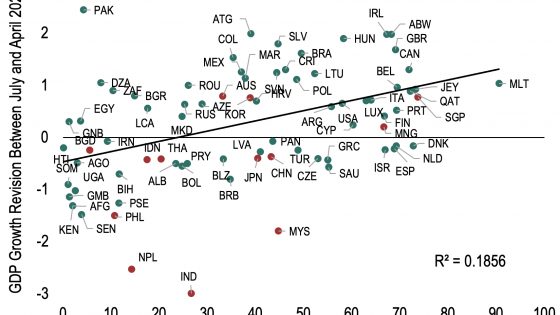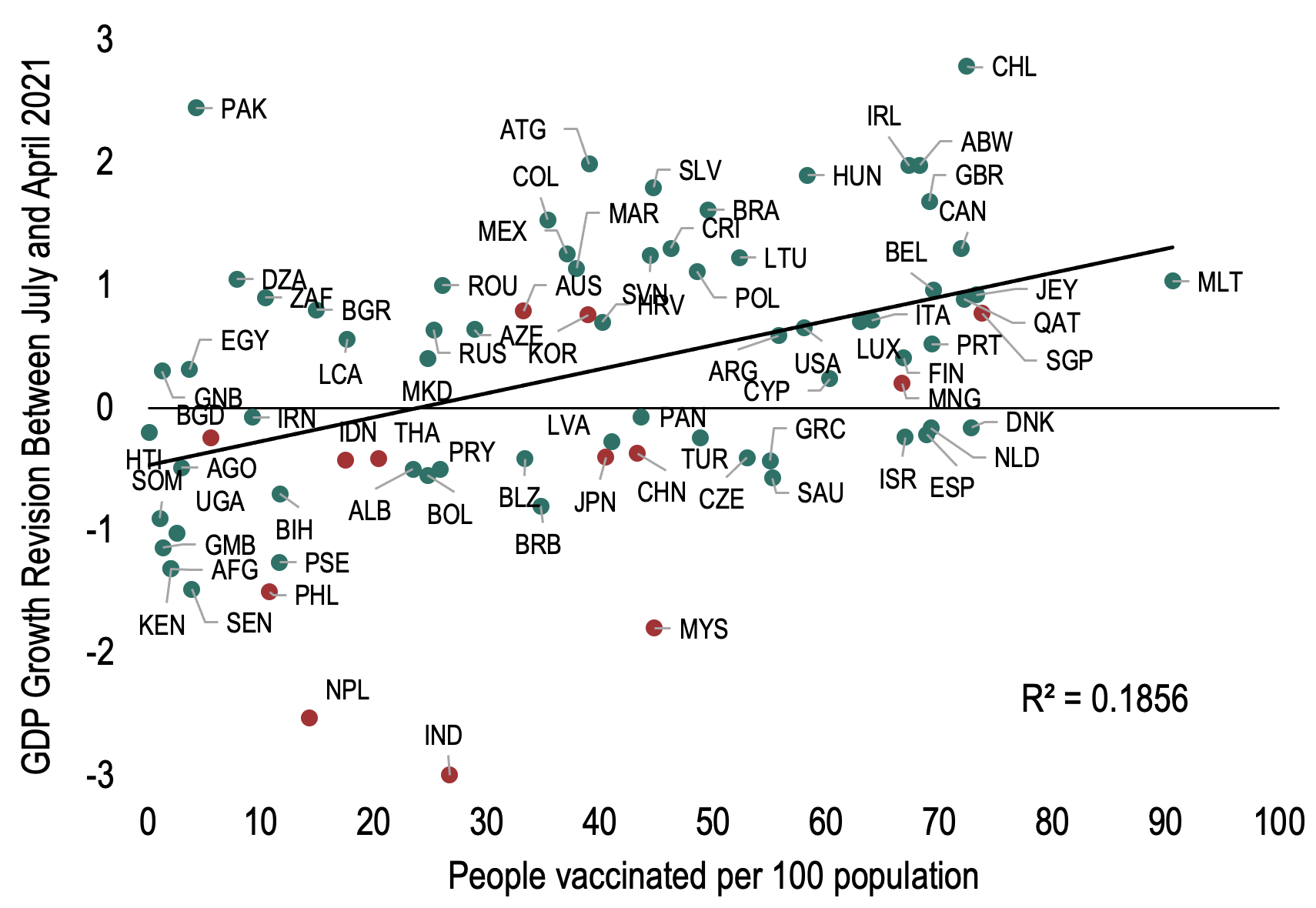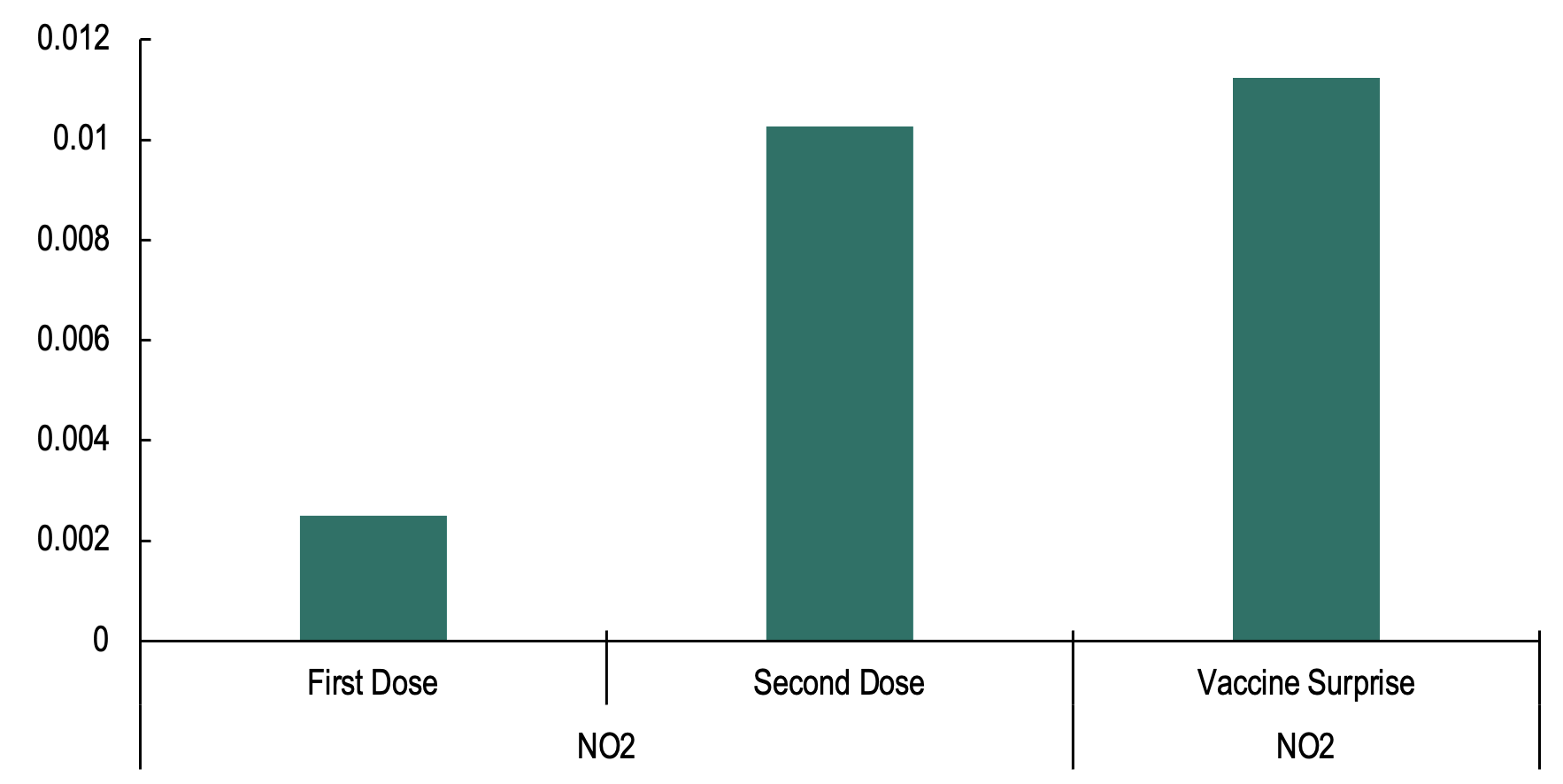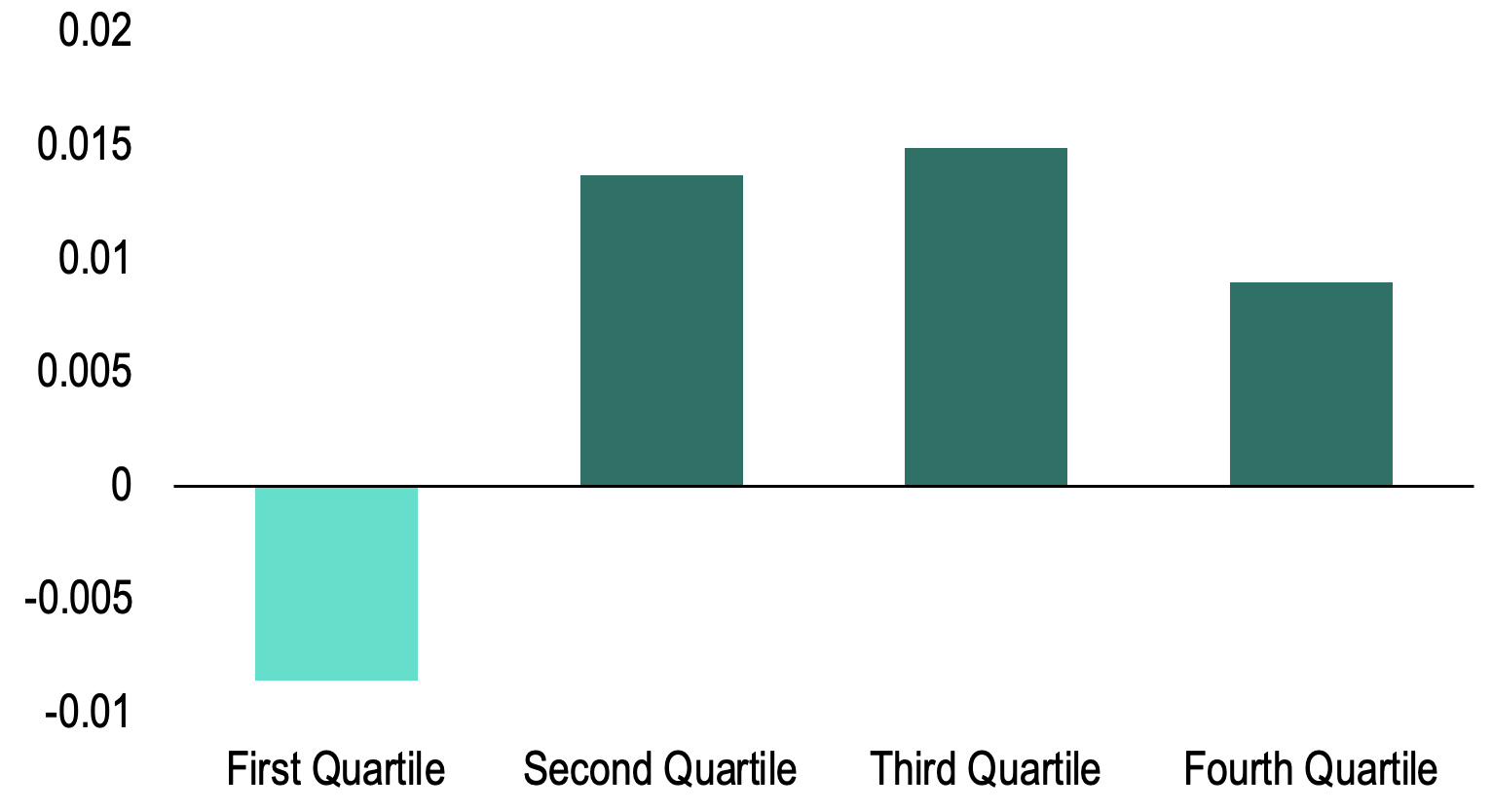The effectiveness of COVID-19 vaccines in reducing virus transmission is well established in the epidemiological literature (Dagan et. al. 2021, Polack et al. 2020, Deb et al. 2021a), but little empirical evidence exists on the effect of vaccine rollouts on economic activity in a cross-country setting. With heterogeneous rollouts in early 2021, swift deployers saw better macroeconomic outcomes compared to slower deployers.
Figure 1 GDP growth revisions and vaccines administered as of the end of July 2021
Sources: IMF World Economic Outlook; Our World in Data Coronavirus Pandemic (COVID-19) Database.
Note: The chart shows the revisions in growth forecasts in percentange points (vertical axis) versus the percent of people in the country who are vaccinated (horizontal axis). Country abbreviations are International Organization for Standardization country codes.
In a recent paper (Deb et al. 2021b), we quantify the average economic effect of vaccine rollouts in a cross-country setting, while examining whether these economic benefits increase non-linearly with higher vaccination rates. In addition, we explore the role of a country’s initial conditions – such as the severity of an outbreak, and the presence of containment measures – in affecting the impact of vaccines on economic activity. Finally, we assess spillovers through macroeconomic linkages, i.e. the extent to which an increase in COVID-19 vaccines (cases) in one country boosts (worsens) economic outcomes in its neighbours.
Effect of COVID-19 vaccines on economic activity
We examine the effect of vaccines administered (first and second doses) on daily nitrogen fioxide (NO2) emissions – our chosen high frequency indicator for economic activity. As we show in (Deb et al. 2020b), this indicator is strongly correlated with lower-frequency economic variables such as industrial production and can be linked to overall economic activity (Lin and McElroy 2011). We try to mitigate reverse causality by controlling for lagged values of the number of COVID-19 cases, lagged values of high-frequency economic indicators, as well as country and time fixed effects, and time trends. To address residual concerns of endogeneity, we construct a novel measure of vaccine surprises (defined as the difference between the share of fully vaccinated individuals and the share of vaccinated individuals predicted by supply-driven vaccine models).
The results suggest that higher vaccination rates boost economic activity: an increase in the vaccination rate per capita (both first and second dose) is associated with an increase in NO2 emissions. We find that surprises in vaccinations are also strongly associated with higher NO2 emissions, with the impact of the vaccine surprise larger than those of the first and second doses. A surprise increase in vaccinations of 10% of the population is associated with an increase in NO2 emissions of about 30%. We also find that the marginal effect of vaccines increases at higher vaccination rates. This is because, as the rollout continues and vaccinations spread to a wider set of people, confidence and mobility improve, as individuals are more willing to reduce voluntary social distancing.
Figure 2 Effect of COVID-19 vaccines on economic indicators (emissions as percent of population)
Source: Deb et al. (2021b).
Note: The bar shows the impact after 1 day of vaccine first and second dose per capita and vaccine surprise per capita on NO2 emissions. Vaccine surprises are defined as the difference between the expected vaccine administrations and the actual full doses administered.
Figure 3 Marginal effect of COVID-19 vaccines on NO2 emissions (emissions as percent of population)
Source: Deb et al. (2021b).
Note: The bar charts denote the impact after 1 day of vaccine surprises per capita at different quartiles on NO2 emissions. The lighter shade indicates the effect is not statistically significant at the 90% level. Vaccine surprises are defined as the difference between the expected vaccine administrations and the actual full doses administered.
The role of containment measures and the severity of an outbreak
The average effects of rollouts on economic outcomes varies over the pandemic cycle. A quick vaccine rollout may not lead to an improvement in economic outcomes if strong containment measures need to be maintained. Our results suggest that when social distancing measures are high, the increase in economic activity due to vaccine rollouts is curtailed. Similarly, the impact of vaccines on economic activity is dampened during severe outbreaks, as people are more likely to socially distance when the risk of transmission is high.
Spillovers from foreign COVID-19 cases and vaccines to economic activity
With the pace of COVID-19 vaccinations uneven across countries, divergent global health and vaccination outcomes could have an indirect effect on a country’s own economic activity levels through macroeconomic linkages such as trade. We explore spillovers from COVID-19 cases and vaccines by constructing daily proxies of ‘foreign’ COVID-19 cases and vaccines in main trading partners, based on bilateral trade flows between countries. The results suggest that foreign COVID-19 cases can lower a country’s NO2 emissions, effectively dampening economic activity through traditional economic linkages. However, the opposite holds for foreign COVID-19 vaccinations, with positive spillovers from increased vaccinations in main trading partner countries reflecting economic effects through trade linkages.
Figure 4 Role of a country’s initial conditions (emissions as percent of the population)
Source: Deb et al. (2021b).
Note: The red (green) bars show the impact of vaccine surprises after one day on NO2 emissions when containment measures or the severity of the outbreak are high (low).
Figure 5 Effect of neighbouring COVID-19 cases and vaccines on a country’s economic outcomes (emissions as percent of population)
Source: Deb et al. (2021b).
Note: The green bars denote the impact of neighboring COVID-19 cases per capita on a country’s NO2 emissions per capita after 30 days. The red bar denotes the effect of neighboring COVID-19 vaccines on a country’s own NO2 emissions per capita, after 30 days.
Authors' note: The views expressed in this column should not be ascribed to the institutions with which the authors are affiliated.
References
Agarwal, R and G Gopinath (2021), "A proposal to end the COVID-19 pandemic", IMF Staff Discussion Notes 2021, no. 004.
Dagan, N, N Barda, E, Kepten et al. (2021), “BNT162b2 mRNA Covid-19 Vaccine in a Nationwide Mass Vaccination Setting”, New England Journal of Medicine, NEJMoa2101765.
Deb, P, D Furceri, J Ostry and N Tawk (2020b), “The economic effects of COVID-19 containment measures”, Covid Economics: Vetted and Real-Time Papers 24: 32–75.
Deb, P, D Furceri, D Jimenez, S Kothari, J Ostry and N Tawk (2021a), “Determinants of COVID-19 Vaccine Rollouts and Their Effects on Health Outcomes”, CEPR Discussion Paper No. 16681.
Deb, P, D Furceri, D Jimenez, S Kothari, J Ostry and N Tawk (2021b), "The Effects of COVID-19 Vaccines on Economic Activity”, CEPR Discussion Paper No. 16681.
Lin, J T and M B McElroy (2011), “Detection from Space of a Reduction in Anthropogenic Emissions of Nitrogen Oxides during the Chinese Economic Downturn”, Atmospheric Chemistry and Physics 11(15): 8171–8188.
Polack, F P, S J Thomas, N Kitchin et al. (2020), “C4591001 Clinical Trial Group. Safety and Efficacy of the BNT162b2 mRNA Covid-19 Vaccine”, New England Journal of Medicine 383(27): 2603-2615.














